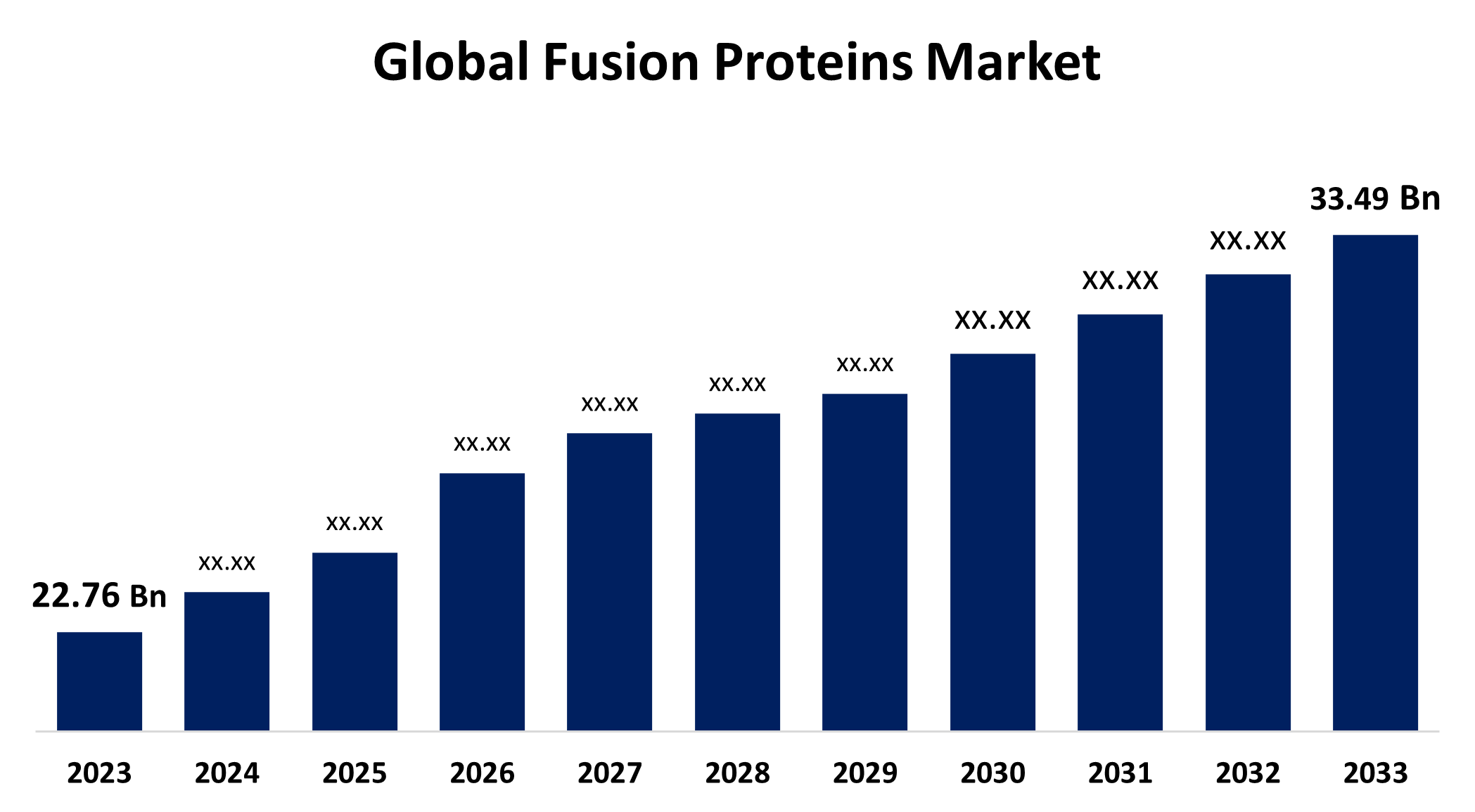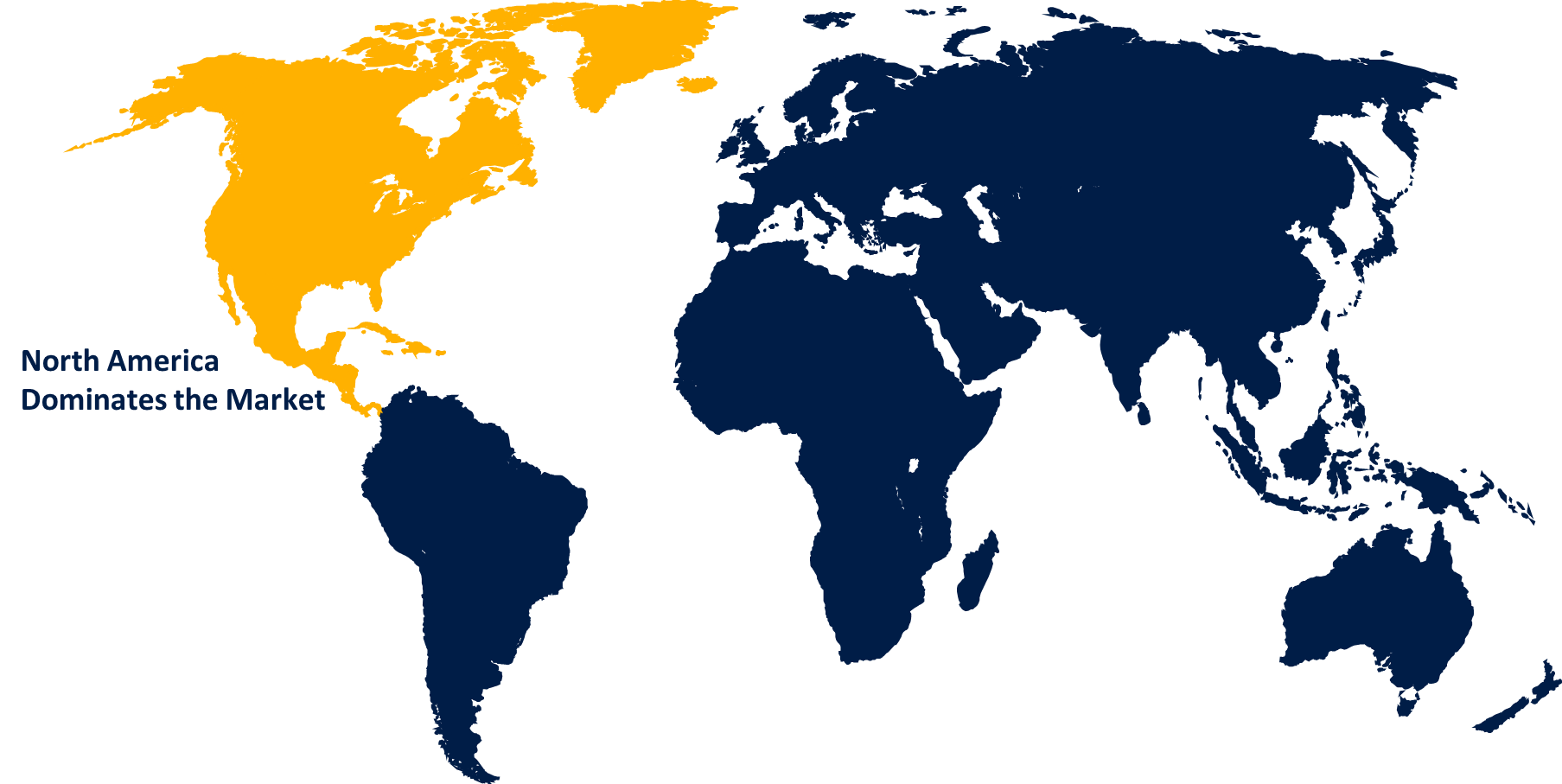Global Fusion Proteins Market Size, Share, and COVID-19 Impact Analysis, By Product (Immunoglobulin (Ig) Fusion Protein, Parathyroid Hormone (PTH) Fusion Protein, Cytokines Recombinant Fusion Protein, and Others), By Application (Biological Technology, Chimeric Protein Drugs, Cancer and Immunological Disorders, and Others), and By Region (North America, Europe, Asia-Pacific, Latin America, Middle East, and Africa), Analysis and Forecast 2023 - 2033
Industry: HealthcareGlobal Fusion Proteins Market Insights Forecasts to 2033
- The Global Fusion Proteins Market Size was Valued at USD 22.76 Billion in 2023
- The Market Size is Growing at a CAGR of 3.94% from 2023 to 2033
- The Worldwide Fusion Proteins Market Size is Expected to Reach USD 33.49 Billion by 2033
- Asia Pacific is Expected to Grow the fastest during the forecast period.

Get more details on this report -
The Fusion Proteins Market Size is Anticipated to Exceed USD 33.49 Billion by 2033, Growing at a CAGR of 3.94% from 2023 to 2033.
Market Overview
Fusion proteins are unique molecules that are usually made up of two proteins, one that provides a particular property of interest and another that is fused with a single known specific receptor. A fusion protein seeks to increase the qualities that are lacking in individual, native proteins and enhance the protein's capacity to treat disease by fusing various gene features. When two protein domains are combined, one serves as the binding receptor while the other adds functionality including increased stability or unique targeting pathways. Fusion proteins are currently being used to treat immunologic and inflammatory disorders, in addition to cancer. Fusion proteins are categorized into numerous categories according to their characteristics. A major factor propelling the growth of the fusion protein market is the rising prevalence of long-term illnesses such as cancer, autoimmune diseases, and inflammatory conditions. Fusion proteins primarily attach to particular cellular receptors or molecular targets implicated in the course of disease, exhibiting adapted therapeutic effects.
The FDA (Food and Drug Administration) provides information on the approval status of fusion protein-based medications and treatments through regulatory approvals and guidance. The FDA data includes information on medicine approval, outcomes of clinical trials, and guidelines for fusion protein regulations. According to the Alzheimer's Association, more than 6.5 million Americans suffer from Alzheimer's disease, the most common form of dementia. Researchers are making significant progress in creating novel medications that specifically target beta-amyloid plaques, one of the disease's characteristic features, to find effective therapies and slow the progression of this life-threatening disorder. Brain protein fragment accumulations known as beta-amyloid plaques can potentially affect cognitive function.
Report Coverage
This research report categorizes the market for the fusion proteins market based on various segments and regions forecasts revenue growth and analyzes trends in each submarket. The report analyses the key growth drivers, opportunities, and challenges influencing the fusion proteins market. Recent market developments and competitive strategies such as expansion, product launch, and development, partnership, merger, and acquisition have been included to draw the competitive landscape in the market. The report strategically identifies and profiles the key market players and analyses their core competencies in each sub-segment of the fusion proteins market.
Global Fusion Proteins Market Report Coverage
| Report Coverage | Details |
|---|---|
| Base Year: | 2023 |
| Market Size in 2023 : | USD 22.76 Billion |
| Forecast Period: | 2023-2033 |
| Forecast Period CAGR 2023-2033 : | 3.94% |
| 2033 Value Projection: | USD 33.49 Billion |
| Historical Data for: | 2019-2022 |
| No. of Pages: | 189 |
| Tables, Charts & Figures: | 110 |
| Segments covered: | By Product, By Application, By Region |
| Companies covered:: | Abnova, Absolute Antibody, Amgen Science, Astellas Pharma, Bristol-Myers Squibb, Chimerigen, Genzyme, Ligand Pharmaceuticals, NOVUS, OriGene Technologies, Inc., Thermo Fisher Scientific Inc., PeproTech, Inc., Novus Biologicals, ProSpec-Tany TechnoGene Ltd., and Others Key Vendors. |
| Pitfalls & Challenges: | COVID-19 Empact,Challenges, Future, Growth, & Analysis |
Get more details on this report -
Driving Factors
The rising incidence of autoimmune disorders and cancer drives the growing demand for advanced fusion protein therapies. Expansion of pharmaceutical manufacturing capacity and development of cutting-edge technology to facilitate the manufacture of fusion proteins. Fusion proteins are currently widely used in therapy, illness prevention, and treatment. These have proven to be effective in treating a variety of diseases, including hemophilia, cancer, diabetes, viral infections, immune system abnormalities, and eye conditions.
Restraining Factors
Strict regulatory rules followed by the fusion protein market from the creation of R&D trials until they entered the fusion proteins market. There are laws governing clinical trials and sale of fusion proteins in several nations the laws may vary depending on the criteria imposed by each nation. Therefore, throughout the projected period, stringent government laws and regulations may hinder the growth of the fusion protein market.
Market Segmentation
The fusion proteins market share is classified into product and application.
- The parathyroid hormone (PTH) fusion protein segment is expected to hold the largest market share through the forecast period.
Based on the product, the fusion proteins market is categorized into immunoglobulin (Ig) fusion protein, parathyroid hormone (PTH) fusion protein, cytokines recombinant fusion protein, and others. Among these, the parathyroid hormone (PTH) fusion protein segment is expected to hold the largest market share through the forecast period. The parathyroid hormone (PTH) fusion proteins join parathyroid hormones with other molecules, which are frequently utilized to treat diseases relating to the bones. The intention of developing parathyroid hormone fusion proteins is to establish new treatments that target bone-related conditions such as osteoporosis and hypoparathyroidism by combining fragments of parathyroid hormone with other protein domains.
- The chimeric protein drugs segment holds the highest market share through the forecast period.
Based on the application, the fusion proteins market is categorized into biological technology, chimeric protein drugs, cancer and immunological disorders, and others. Among these, the chimeric protein drugs segment holds the highest market share through the forecast period. The chimeric drugs essential part is developing medicinal drugs by combining components from multiple proteins. Compared to conventional treatments, these designed proteins, which frequently target certain disease pathways or cellular receptors, provide increased efficacy and fewer adverse effects. The application of them in the treatment of ailments including cancer, autoimmune illnesses, and infectious infections is growing, which contributes to consumer acceptance and propelling the market's rise.
Regional Segment Analysis of the Fusion Proteins Market
- North America (U.S., Canada, Mexico)
- Europe (Germany, France, U.K., Italy, Spain, Rest of Europe)
- Asia-Pacific (China, Japan, India, Rest of APAC)
- South America (Brazil and the Rest of South America)
- The Middle East and Africa (UAE, South Africa, Rest of MEA)
North America is anticipated to hold the largest share of the fusion proteins market over the predicted timeframe.

Get more details on this report -
North America is projected to hold the largest share of the fusion proteins market over the forecast period. This dominance is due to the use of modern fusion proteins is growing, as is the efficacy of fusion protein therapy. Increased incidence of eye-related disorders, the number of people with diabetes, and FDA approvals for fusion protein-based therapies are projected to propel market expansion in North America. Furthermore, the increasing initiatives to conduct research and development in the region to create drugs using fusion protein are expected to contribute to the market's growth during the forecast period.
Asia Pacific is expected to grow at the fastest CAGR growth in the fusion proteins market during the forecast period. The Asia Pacific market is anticipated to grow due to the rapidly increasing demand for bio-therapeutic drugs derived from fusion protein. This demand is expected to originate from the increased prevalence of eye diseases, hemophilia, autoimmune disease, and diabetes brought on by the rapidly growing geriatric population in countries such as China, India, and Japan. Furthermore, it is projected that the public in those countries will be more aware of the advantages of fusion protein-based medications, which will accelerate the market's revenue growth in this area.
Competitive Analysis:
The report offers the appropriate analysis of the key organizations/companies involved within the fusion proteins market along with a comparative evaluation primarily based on their product offering, business overviews, geographic presence, enterprise strategies, segment market share, and SWOT analysis. The report also provides an elaborative analysis focusing on the current news and developments of the companies, which includes product development, innovations, joint ventures, partnerships, mergers & acquisitions, strategic alliances, and others. This allows for the evaluation of the overall competition within the market.
List of Key Companies
- Abnova
- Absolute Antibody
- Amgen Science
- Astellas Pharma
- Bristol-Myers Squibb
- Chimerigen
- Genzyme
- Ligand Pharmaceuticals
- NOVUS
- OriGene Technologies, Inc.
- Thermo Fisher Scientific Inc.
- PeproTech, Inc.
- Novus Biologicals
- ProSpec-Tany TechnoGene Ltd.
- Others
Key Target Audience
- Market Players
- Investors
- End-users
- Government Authorities
- Consulting And Research Firm
- Venture capitalists
- Value-Added Resellers (VARs)
Recent Developments
- In June 2024, A worldwide license agreement was finalized for an IL-18 targeted fusion protein between Evommune, Inc., a clinical-stage biotechnology company that discovers and develops novel treatments for immune-mediated inflammatory diseases, and AprilBio Co., Ltd., a South Korean biopharmaceutical company committed to developing specialized biologics and antibody drugs.
- In January 2024, Abzena announced AbZelect and AbZelectPRO, two novel cell line development (CLD) platforms meant to accelerate the creation of production cell lines for antibodies and recombinant proteins. The platforms are designed to help complicated biologic drug development move quickly from preclinical testing to clinical trials and IND filing.
Market Segment
This study forecasts revenue at global, regional, and country levels from 2020 to 2033. Spherical Insights has segmented the fusion proteins market based on the below-mentioned segments:
Global Fusion Proteins Market, By Product
- Immunoglobulin (Ig) Fusion Protein
- Parathyroid Hormone (PTH) Fusion Protein
- Cytokines Recombinant Fusion Protein
- Others
Global Fusion Proteins Market, By Application
- Biological Technology
- Chimeric Protein Drugs
- Cancer and Immunological Disorders
- Others
Global Fusion Proteins Market, By Regional Analysis
- North America
- US
- Canada
- Mexico
- Europe
- Germany
- UK
- France
- Italy
- Spain
- Russia
- Rest of Europe
- Asia Pacific
- China
- Japan
- India
- South Korea
- Australia
- Rest of Asia Pacific
- South America
- Brazil
- Argentina
- Rest of South America
- Middle East & Africa
- UAE
- Saudi Arabia
- Qatar
- South Africa
- Rest of the Middle East & Africa
Frequently Asked Questions (FAQ)
-
1.What is the CAGR of the global fusion proteins market over the forecast period?The global fusion proteins market is to expand at 3.94% during the forecast period.
-
2.Which region is expected to hold the highest share in the global fusion proteins market?The North America region is expected to hold the largest share of the global fusion proteins market.
-
3.Who are the top key players in the fusion proteins market?The key players in the global fusion proteins market are Abnova, Absolute Antibody, Amgen Science, Astellas Pharma, Bristol-Myers Squibb, Chimerigen, Genzyme, Ligand Pharmaceuticals, NOVUS, OriGene Technologies, Inc., Thermo Fisher Scientific Inc., PeproTech, Inc., Novus Biologicals, ProSpec-Tany TechnoGene Ltd., and others.
Need help to buy this report?